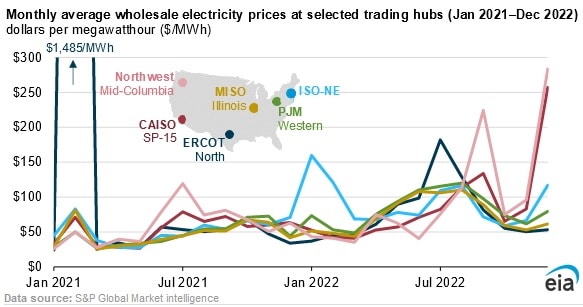Extreme Weather Caused Wholesale Electricity Price Volatility in the U.S. in 2022: EIA

The U.S. trading hubs’ average wholesale electricity prices increased in 2022 compared with 2021 on account of extreme weather conditions and the limited supply of coal to replace higher-priced natural gas, according to a Jan. 10 report from the U.S. Energy Information Administration. Extreme weather and manpower shortages in the railroad and coal mine industries also restricted the ability to switch from expensive gas to cheaper coal. The electricity prices rose in most of the trading hubs except the Electric Reliability Council of Texas (ERCOT).
Major weather events triggering spike in wholesale electricity price in 2022 by month:
January: The cost of New England wholesale power increased in January as a result of the cold weather, a winter storm, and pipeline bottlenecks in New England. The wholesale electricity price averaged $160 per MWh during the month.
July: A Texas heat wave in July led to record-breaking electrical consumption at ERCOT, which operates the state’s electrical grid and represents around 90 percent of the state’s electric load. The wholesale electricity price averaged $182 per MWh during the month. During the heatwave, Texas’s wind power declined, which was a significant source of electricity in the state, and natural gas-fired generation increased to offset the decline in wind generation.
September: A heatwave that affected the western U.S. in early September caused record-breaking electricity consumption, and the price rise began in the Northwest, where the average monthly price of energy in the Northwest Mid-Columbia market hub was $224 per MWh. During the heatwave, California also faced an increase in the wholesale electricity price, which averaged $134 per MWh during the month.
December: Winter storms and cold temperatures throughout December in the Western Pacific regions of the United States resulted in record-high electricity prices, where the wholesale electricity price averaged $257 per MWh at the CAISO N-15 hub and $283 per MWh at the Northwest Mid-Columbia market hub. Natural gas spot prices in the western hubs increased to around 10 times those at Henry Hub, the global benchmark price, as a result of the cold weather and supply shortages.
Since natural gas is often the most expensive fuel for electricity generation, the price of natural gas affects the cost of the hours that natural gas-fired generators operate. Natural gas prices continued to rise in January 2022, spurred by the expansion of the Asian economy and limitations on Russian pipeline and liquefied natural gas shipments to Europe. U.S. LNG exports surged as a result of the strong global demand for natural gas, which raised natural gas costs for domestic consumers. Early in January 2022, the price of natural gas was $3.70 per million British thermal units (MMBtu), but by late August 2022, it had risen to approximately $10.00 per MMBtu.
EnerKnol Pulses like this one are powered by the EnerKnol Platform—the first comprehensive database for real-time energy policy tracking. Sign up for a free trial below for access to key regulatory data and deep industry insights across the energy spectrum.
ACCESS FREE TRIAL


